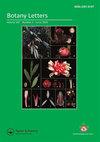非洲基加利(林)Benth的潜在种子传播机制。在城市栖息地
IF 1.3
4区 生物学
Q3 PLANT SCIENCES
引用次数: 0
摘要
摘要:众所周知,非洲基加利表现出巨型动物群综合征。随着时间的推移,许多大型动物类群已经灭绝,该物种似乎已经适应了不断变化的环境,通过确保其种子通过替代的传播者传播。本研究报告了生长在印度的非洲K.africana个体在物种自然环境之外所采用的种子传播机制。巨大的——约2.0公斤——不裂且没有吸引力的果实保留了没有翅膀的种子。在一个果实中平均存在的300多个种子中,约92%在成熟时保持活力,1年后活力随着时间的推移而下降。我们观察到许多白蚁(台湾白蚁)引发了掉落果实的分解,尤其是在季风期间。三只条纹松鼠(Funambulus palmarum)被归类为分散囤积的啮齿类动物,然后获取这些水果及其种子,并主动携带约48%的破壳种子到距离母树40米的地方。这两种动态载体的协调活动确保了在研究地点成功地在非洲K.africana传播种子,这表明该物种可能已经找到了适应新环境的方法。本文章由计算机程序翻译,如有差异,请以英文原文为准。
Potential seed dispersal mechanism of Kigelia africana (Lam.) Benth. in an urban habitat
ABSTRACT Kigelia africana is known to exhibit megafaunal syndrome. Many mega faunal taxa having become extinct with time, the species seems to have adapted to its changing environment by ensuring the dispersal of its seeds by alternative dispersers. The present investigation reports the mechanism of seed dispersal adopted by individuals of K. africana grown in India, outside the species natural environment. The massive – ~2.0 kg – indehiscent and unattractive fruits retain the wingless seeds. Of more than 300 seeds present in a fruit in average, approximately 92% remained viable at maturity, and the viability decreased over time after 1 year. We observed that numerous termites (Coptotermes formosanus) initiated the disintegration of the fallen fruits particularly during monsoon. Three-striped squirrels (Funambulus palmarum), classified as scatter hoarding rodents, then accessed these fruits and their seeds, and actively carried about 48% seeds with broken coats to a distance of 40 m away from the mother trees. The coordinated activity of these two dynamic vectors ensured successful seed dispersal in K. africana at the study site, suggesting that the species may have developed a way to adapt to its new environment.
求助全文
通过发布文献求助,成功后即可免费获取论文全文。
去求助
来源期刊

Botany Letters
Agricultural and Biological Sciences-Plant Science
CiteScore
3.10
自引率
6.70%
发文量
54
期刊介绍:
Botany Letters is an international scientific journal, published by the French Botanical Society (Société botanique de France) in partnership with Taylor & Francis. Botany Letters replaces Acta Botanica Gallica, which was created in 1993, building on over a century of renowned publications by the Société botanique de France.
 求助内容:
求助内容: 应助结果提醒方式:
应助结果提醒方式:


